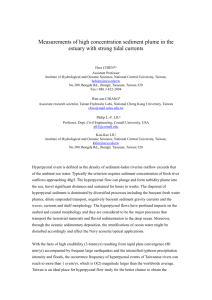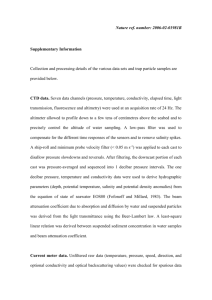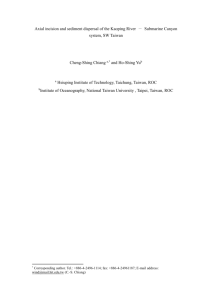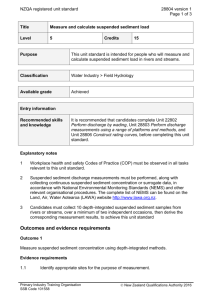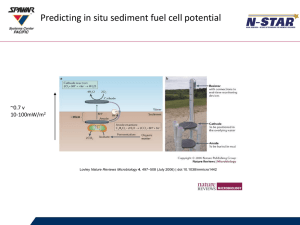Abstract
advertisement
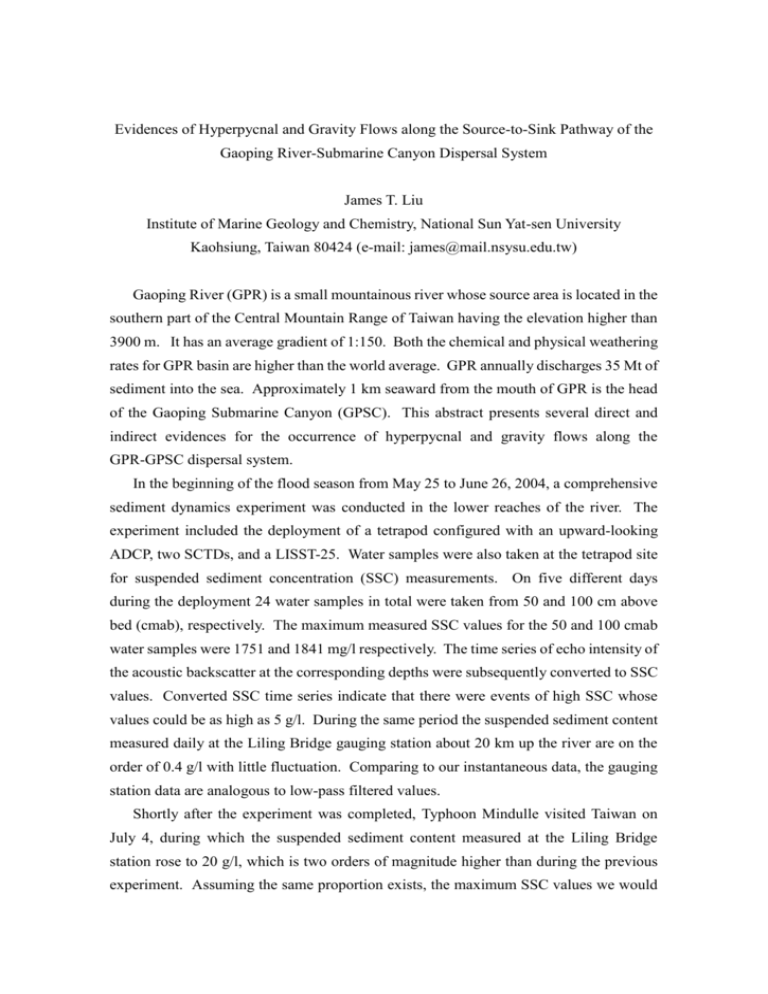
Evidences of Hyperpycnal and Gravity Flows along the Source-to-Sink Pathway of the Gaoping River-Submarine Canyon Dispersal System James T. Liu Institute of Marine Geology and Chemistry, National Sun Yat-sen University Kaohsiung, Taiwan 80424 (e-mail: james@mail.nsysu.edu.tw) Gaoping River (GPR) is a small mountainous river whose source area is located in the southern part of the Central Mountain Range of Taiwan having the elevation higher than 3900 m. It has an average gradient of 1:150. Both the chemical and physical weathering rates for GPR basin are higher than the world average. GPR annually discharges 35 Mt of sediment into the sea. Approximately 1 km seaward from the mouth of GPR is the head of the Gaoping Submarine Canyon (GPSC). This abstract presents several direct and indirect evidences for the occurrence of hyperpycnal and gravity flows along the GPR-GPSC dispersal system. In the beginning of the flood season from May 25 to June 26, 2004, a comprehensive sediment dynamics experiment was conducted in the lower reaches of the river. The experiment included the deployment of a tetrapod configured with an upward-looking ADCP, two SCTDs, and a LISST-25. Water samples were also taken at the tetrapod site for suspended sediment concentration (SSC) measurements. On five different days during the deployment 24 water samples in total were taken from 50 and 100 cm above bed (cmab), respectively. The maximum measured SSC values for the 50 and 100 cmab water samples were 1751 and 1841 mg/l respectively. The time series of echo intensity of the acoustic backscatter at the corresponding depths were subsequently converted to SSC values. Converted SSC time series indicate that there were events of high SSC whose values could be as high as 5 g/l. During the same period the suspended sediment content measured daily at the Liling Bridge gauging station about 20 km up the river are on the order of 0.4 g/l with little fluctuation. Comparing to our instantaneous data, the gauging station data are analogous to low-pass filtered values. Shortly after the experiment was completed, Typhoon Mindulle visited Taiwan on July 4, during which the suspended sediment content measured at the Liling Bridge station rose to 20 g/l, which is two orders of magnitude higher than during the previous experiment. Assuming the same proportion exists, the maximum SSC values we would have measured near the river mouth during the typhoon would have been 500 g/l, which exceeds the suggested threshold (40 g/l) for the presence of hyperpycnal events (Mulder and Syvitski, 1995). This fact suggests that hyperpycnal events could exist in the GPR during typhoon events. In previous studies, benthic nepheloid layer (BNL) has been observed in the head region of the GPSC throughout a year. The top of the BNL could be as high as 100 m above the canyon floor of which the suspended sediment concentration (SSC) could be as high as 30 mg/l (Liu et al., 2002). Both the thickness and SSC in the BNL are modulated by the diurnal tide. Silt comprises the largest size-class in the suspended sediment population (Liu and Lin, 2004) in BNL. During one episodic typhoon event (Typhoon Nakri in 2002), the amount of suspended sediment (measured as volume concentration) within the BNL increased by one order of magnitude. Furthermore, the peaks of the suspended sediment concentration coincided with the maximum ebbing tide, resulting in an episode of strong down-canyon transport of suspended sediment during the typhoon. This phenomenon suggests that typhoon could trigger down-canyon flushing of suspended sediment near the canyon floor, which might lead to the generation of turbidity currents (Liu et al., 2006). The above case study indicates that gravity flows that are not directly related to the hyperpycnal plume of the river could be generated in the deeper part of the submarine canyon during typhoon events. The mechanisms are not clear at this point. However, there is another scenario that could shed more light. A sediment trap mooring was deployed in GPSC approximately 20 km from the mouth of GPR in the depth of 654 m between July 7 and Sept. 11, 2008. This mooring was configured with a non-sequential (USGS-type) sediment trap whose aperture was located at 47 m above the sea floor. During this period, two typhoons made landfall on Taiwan and two others passed through Luzon Strait. At the onset of the first typhoon, the net flow near the canyon floor abruptly turned from up-canyon-directed to down-canyon-directed. Simultaneously the water temperature rose by 4-5 degrees. Temperature recorded by a series of mini loggers (thermometers) on the sediment trap array shows that the sudden increase of temperature is confined to the water below 450 m depth for the entire span of this typhoon. Yet, the long-range ADCP deployed next to the sediment array does not show increased downward water movement. This suggests worm water was cascading down the canyon thalweg from the landward part of the canyon, not sinking directly from above. Associated with this cascading warm water is tremendous amount of material accumulated in the lower trap during a short period of one day such that the 175 cm-long empty space in the coreliner attached to the funnel of the USGS-type trap was not only filled up, but overflew into the funnel. The combined cascading warm water and extremely high accumulation rate in the sediment trap near the canyon floor suggest a large gravity flow event down the canyon in the peak of the typhoon. Since the tidal propagation associated with the transport of water and suspended sediment from offshore are up-canyon but episodic sediment transport associated with hyperpycnal and gravity flows triggered by typhoons or by earthquakes or by canyon wall slumping are down-canyon, we hypothesize that the frequency of occurrence and intensity of these episodic transport events determine weather the upper portion of the Gaoping Submarine Canyon is filling up, down-cutting, or is just a conduit for sediment by-pass. References Mulder, T., and Syvitski, J.P.M., 1995, Turbidity currents generated at river mouths during exceptional discharges to the world oceans: Journal of Geology, v. 103: 285-299. Liu, J.T., H.-L. Lin, and J.-J. Hung, 2006. A submarine canyon conduit under typhoon conditions off Southern Taiwan. Deep Sea Research I, 53, 223-240. Liu, J.T. and Lin, H.-L., 2004. Sediment dynamics in a submarine canyon: a case of river-sea interaction. Marine Geology, 207 (1-4), 55-81. Liu, J.T., Liu, K.-j., and Huang, J.-S., 2002. The influence of a submarine canyon on river sediment dispersal and inner shelf sediment movements: a perspective from grain-size distributions. Marine Geology, 181 (4), 357-386. Liu, J.T., Hung, J.-J., Lin, H.-L., Huh, C.-A., Lee, C.-L., Hsu, R.T., Huang, Y.-W., and Chu, J.C., 2008. From suspended particles to strata: the fate of terrestrial substances in the Gaoping (Kaoping) Submarine Canyon. Journal of Marine System, 76 (4).
